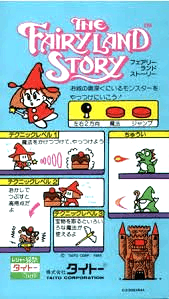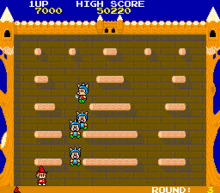The Fairyland Story
The Fairyland Story[lower-alpha 1] is a platform arcade game developed and published by Taito in 1985. In the game, the player controls the witch Ptolemy, with the objective being to clear the screen of all enemies. Ptolemy can use her wand to turn the enemies into large cakes, which she can then push off of platforms onto other enemies, which will squash them and award bonus points. Various Items that increase Ptolemy's projectile radius, as well as kill multiple enemies at the same time, will also appear throughout the stages.
| The Fairyland Story | |
|---|---|
 Arcade instruction card. | |
| Developer(s) | Taito |
| Publisher(s) | Taito |
| Designer(s) | Hiroshi Tsujino |
| Composer(s) | Tadashi Kimijima |
| Platform(s) | Arcade, MSX, X68000, Mobile phone |
| Release | |
| Genre(s) | Platform |
| Mode(s) | Single-player, multiplayer (alternating turns) |
| Cabinet | Upright |
| Arcade system | Taito Fairyland Story |
| Sound | Mono |
| Display | Horizontal orientation, Raster, 256 x 224 resolution |
Gameplay has often been compared to other Taito platform games, such as Bubble Bobble, The NewZealand Story and Liquid Kids. A Japanese MSX version developed and published by Hot-B was released in 1987, while a Sharp X68000 port was developed and published in 1991 by SPS. The Fairyland Story would be included in the arcade game collections Taito Legends 2, Taito Memories Jokan, and Taito Legends Power-Up. A 2003 port for Japanese mobile phones was made available through the I-mode and EZweb network services.
Gameplay

The Fairyland Story is a platform arcade game. The player controls the witch Ptolemy through a series of single-screen stages, with the objective being to defeat all of the enemies on each screen. Ptolemy's main weapon is her projectile magic, which will temporarily transform the enemies into large cakes.[1] While in a "caked" form, the enemies can be destroyed either by further magic attacks or by being dropped off a platform, possibly squashing other enemies below.[1] Squashing more than one enemy results in an award of more points and, sometimes, in extra bonuses. 2000 points are awarded for squashing an enemy below a cake, with each additional enemy doubling the number of points awarded.[1] If two or more enemies are killed at once in one spot, a coin will appear in that spot, which may be collected for additional points, and if more are collected, will multiply in points, so as long the player doesn't lose a life.[1]
Ptolemy's enemies are based upon typical fantasy beings - these include Orcs[2][3], pig-like soldiers, Salamanders[2][3], dragon-like creatures that can breathe fire, Wizards[2][3], mages that can make Ptolemy shrink and disappear, Clerics[2][3], bishops who can multiply themselves, Golems[2][3], and Wraiths[2][3], hooded creatures can phase through Ptolemy's magic.[4][3][2] If Ptolemy takes too long to clear a level of a last remaining enemy, eventually that enemy will disappear without an award of points.[1] If, however, Ptolemy takes too long to clear more than one enemy from the level, a flying devil, named Horned[2][3], appears to kill Ptolemy. The devil is invulnerable to Ptolemy's magic, and the only way to survive is for Ptolemy to kill all remaining enemies.[1] This game element is very similar to the "Beluga" or "Skel Monsta" fish that limit the time allowed for each level in the later Taito game Bubble Bobble.
Ptolemy's deaths are animated in different ways, depending on the enemy who kills her. She can sometimes collect some utility bonuses which increase her power and range of her magic for a short while or offensive bonuses that, most usually, result in the cake-ification and destruction of all on-screen enemies.[2][3] At various intervals between levels, an intermission screen appears during the game showing Ptolemy riding on the back of a large, wingless blue dragon named Rodemy.[2] A message appears on each of these intermission screens, either congratulating the player or warning of some hazard in the next level. Many of these messages contain incorrect English idioms or grammar typical of Engrish.
Development and release
The Fairyland Story was released by Taito in Japan in July 1985[5] and in North America later that year. It was designed by Hiroshi "ONIJIST" Tsujino, best known for designing The Ninja Warriors, with music composed by Tadashi Kimijima.[6] While working at Taito's Yokohama Institute, Tsujino drafted an idea for a game where the player had to defeat enemies by crushing them under large cakes, which he claims to be partly inspired by his addiction to Namco's Dig Dug.[6] Early versions of the game were said to have been "monotonous" and left Tsujino largely unhappy with the outcome — being inspired by Broderbund's Lode Runner for the Apple II, he gave the game a larger emphasis on strategy and memorization, featuring reworked stage designs.[6] The game's final boss took a week to complete.[6] Executives at Taito were against the idea of the game having an ending and demanded that the team remove it, however Tsujino ignored their request.[6]
Conversions
An MSX port, developed and published by Hot-B, was released on September 3, 1987. This port featured degraded graphics and sound from the arcade version, typical for most arcade ports on the MSX, but had new stages, to perhaps make up for the degradation in graphics and sound. Some of these new stages are based on other Taito properties, like level 37 resembling Mr. Chack'n from Chack'n Pop. The port also featured two new enemies, the Iron Golem, which is the same as the Golem enemy but immune to Ptolemy's magic, and Fleck, an enemy that can use the same magic as Ptolemy.[2][4] Hot-B was also developing a port for the Famicom, but the port was later cancelled for unknown reasons.[7] Later, in 1991, a Sharp X68000 port was developed and published by SPS, and was released on September 27, 1991. Unlike the MSX port, however, this was a more straightforward port of the arcade version, like most arcade ports on the Sharp X68000. It added several features not found in the original arcade version, like level progress and high score saving, and the choice between two soundtracks, the choices being an emulation of the original soundtrack, or a remixed soundtrack.[4][3] In 2003, a port was made available for Japanese mobile phones via the I-mode and EZweb network services. Not much information is known about this port besides some screenshots, and some of the music from this port appearing in a soundtrack album for mobile games made by Taito.[4][8] Emulated versions of the original arcade version would later be included on the arcade collections Taito Legends 2, Taito Memories Jokan, and Taito Legends Power-Up.[4][9]
Reception
Reviewing Taito Legends 2, Kristan Reed of Eurogamer wrote The Fairyland Story "is a lot of fun - although lacks the two-player co-op fun, sadly. (...) Hugely addictive, though."[9]
Legacy
Ptolemy appears as a player character in Space Invaders DX (1994), Pop'n Pop (1998), Daifugo Party (2010), and Arkanoid vs. Space Invaders (2017).[10] She has also made cameo appearances in several other games, including The New Zealand Story (1988), Bubble Symphony (1994), Bubble Memories (1996), and Arkanoid DS (2007).[11][10] Rainbow Islands (1987) has a secret island based on The Fairyland Story, named Magical Island, with the enemies and music from it being used in the secret island.[10] Ptolemy herself does not appear in most versions of Rainbow Islands that feature the secret island, however, she does make a cameo appearance in the Game Boy Color port of Rainbow Islands in the cutscenes proceeding and after Magical Island.[10] The Worm enemy makes appearances in both Don Doko Don (1989) and Don Doko Don 2 (1991).[10] Many of the Bubble Bobble and The New Zealand Story gameplay elements, and even some graphics and bonuses, first appeared in The Fairyland Story.[11][12]
Notes
References
- Tursi, Lee (15 December 2019). "Fairyland Story, The". Hardcore Gaming 101. Archived from the original on 16 December 2019. Retrieved 16 December 2019.
- GA-Yume / HOTB (1987). The Fairyland Story manual (JP) (in Japanese).
- SPS (1991). The Fairyland Story (Sharp X68000) manual (in Japanese).
- "The Fairyland Story - THANK YOU FOR YOUR BRAVE ACT". gaminghell.co.uk. Retrieved 2019-05-06.
- Akagi, Masumi (13 October 2006). タイトー (Taito). アーケードTVゲームリスト 国内•海外編 (1971-2005) (in Japanese) (1st ed.). Amusement News Agency. p. 42. ISBN 978-4990251215.
- "【第6回リレーブログ クリエーター編】"ニンジャウォリアーズ"辻野様". BEEP!. 29 October 2019. Archived from the original on 1 June 2019. Retrieved 26 October 2019.
- "発売中止のファミコンソフトリスト" [Cancelled Famicom software list] (in Japanese). Retrieved 2019-05-06.
- "ZTTL-9002 | TAITO MOBILE PHONE GAME SOUND COLLECTION Vol.1 - VGMdb". vgmdb.net. Retrieved 2019-05-06.
- Reed, Kristan (2006-03-31). "Taito Legends 2". Eurogamer.net. Retrieved 2015-06-27.
- "The Fairyland Story - WHAT IS "DRACOLISK"? WHERE IS THE DIAMOND?". gaminghell.co.uk. Retrieved 2019-05-06.
- "The Ultimate Guide To The New Zealand Story". NowGamer.com. 2014-01-10. Archived from the original on 2018-03-10. Retrieved 2015-06-27.
- "The Fairyland Story · Games of Our Lives · The A.V. Club". Avclub.com. 2006-09-11. Retrieved 2015-06-27.
External links
- The Fairyland Story at the International Arcade Museum